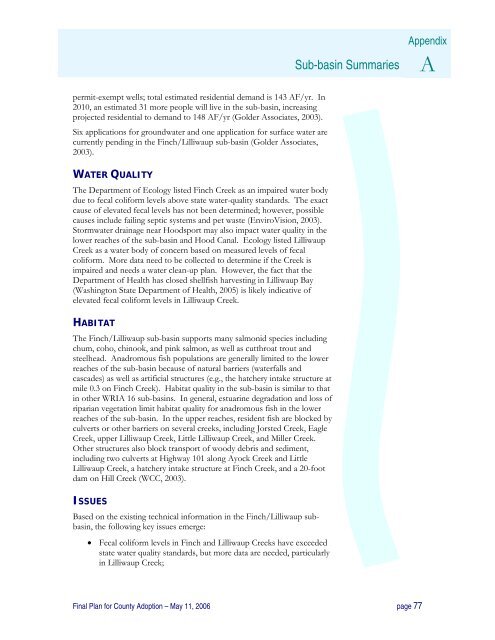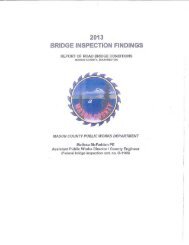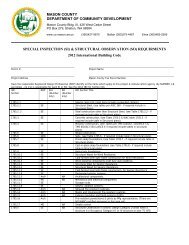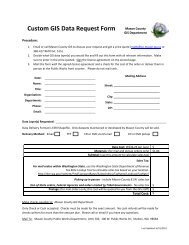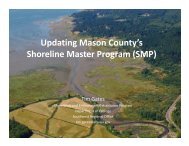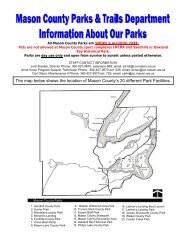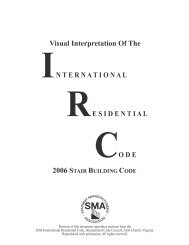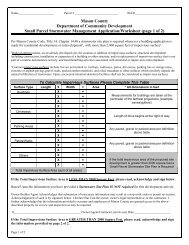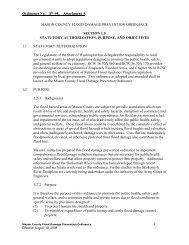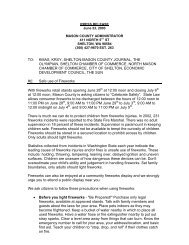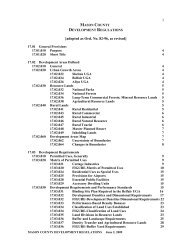Watershed Management Plan - Mason County
Watershed Management Plan - Mason County
Watershed Management Plan - Mason County
You also want an ePaper? Increase the reach of your titles
YUMPU automatically turns print PDFs into web optimized ePapers that Google loves.
Sub-basin Summaries<br />
Appendix<br />
A<br />
permit-exempt wells; total estimated residential demand is 143 AF/yr. In<br />
2010, an estimated 31 more people will live in the sub-basin, increasing<br />
projected residential to demand to 148 AF/yr (Golder Associates, 2003).<br />
Six applications for groundwater and one application for surface water are<br />
currently pending in the Finch/Lilliwaup sub-basin (Golder Associates,<br />
2003).<br />
WATER QUALITY<br />
The Department of Ecology listed Finch Creek as an impaired water body<br />
due to fecal coliform levels above state water-quality standards. The exact<br />
cause of elevated fecal levels has not been determined; however, possible<br />
causes include failing septic systems and pet waste (EnviroVision, 2003).<br />
Stormwater drainage near Hoodsport may also impact water quality in the<br />
lower reaches of the sub-basin and Hood Canal. Ecology listed Lilliwaup<br />
Creek as a water body of concern based on measured levels of fecal<br />
coliform. More data need to be collected to determine if the Creek is<br />
impaired and needs a water clean-up plan. However, the fact that the<br />
Department of Health has closed shellfish harvesting in Lilliwaup Bay<br />
(Washington State Department of Health, 2005) is likely indicative of<br />
elevated fecal coliform levels in Lilliwaup Creek.<br />
HABITAT<br />
The Finch/Lilliwaup sub-basin supports many salmonid species including<br />
chum, coho, chinook, and pink salmon, as well as cutthroat trout and<br />
steelhead. Anadromous fish populations are generally limited to the lower<br />
reaches of the sub-basin because of natural barriers (waterfalls and<br />
cascades) as well as artificial structures (e.g., the hatchery intake structure at<br />
mile 0.3 on Finch Creek). Habitat quality in the sub-basin is similar to that<br />
in other WRIA 16 sub-basins. In general, estuarine degradation and loss of<br />
riparian vegetation limit habitat quality for anadromous fish in the lower<br />
reaches of the sub-basin. In the upper reaches, resident fish are blocked by<br />
culverts or other barriers on several creeks, including Jorsted Creek, Eagle<br />
Creek, upper Lilliwaup Creek, Little Lilliwaup Creek, and Miller Creek.<br />
Other structures also block transport of woody debris and sediment,<br />
including two culverts at Highway 101 along Ayock Creek and Little<br />
Lilliwaup Creek, a hatchery intake structure at Finch Creek, and a 20-foot<br />
dam on Hill Creek (WCC, 2003).<br />
ISSUES<br />
Based on the existing technical information in the Finch/Lilliwaup subbasin,<br />
the following key issues emerge:<br />
• Fecal coliform levels in Finch and Lilliwaup Creeks have exceeded<br />
state water quality standards, but more data are needed, particularly<br />
in Lilliwaup Creek;<br />
Final <strong>Plan</strong> for <strong>County</strong> Adoption – May 11, 2006 page 77


